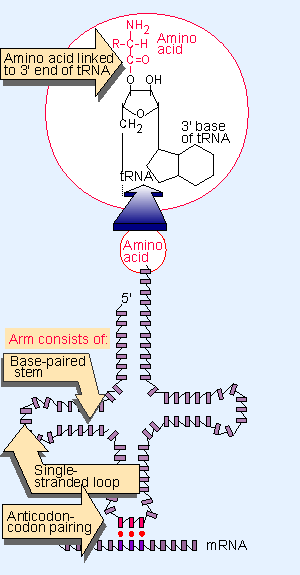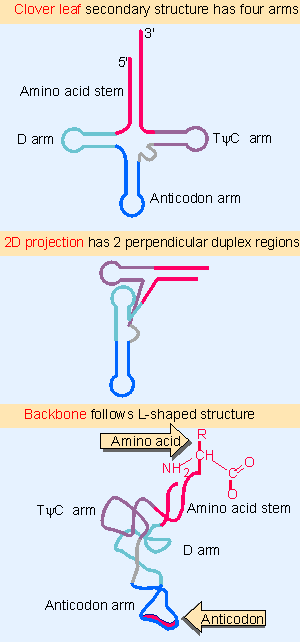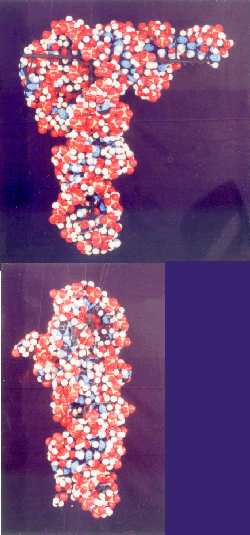2. Transfer RNA is the adapter
5.2 Transfer RNA is the adapter |
| Key terms defined in this section |
| Aminoacyl-tRNA is transfer RNA carrying an amino acid; the covalent linkage is between the NH2 group of the amino acid and either the 3´- or 2´-OH group of the terminal base of the tRNA. Aminoacyl-tRNA synthetases are enzymes responsible for covalently linking amino acids to the 2´- or 3´-OH position of tRNA. Anticodon is a trinucleotide sequence in tRNA which is complementary to the codon in mRNA and enables the tRNA to place the appropriate amino acid in response to the codon. Loop is a single-stranded region at the end of a hairpin in RNA (or single-stranded DNA); corresponds to the sequence between inverted repeats in duplex DNA. Stem is the base-paired segment of a hairpin. |
Messenger RNA can be distinguished from the apparatus responsible for its translation by the use of cell-free systems to synthesize proteins in vitro. A protein-synthesizing system from one cell type can translate the mRNA from another, demonstrating that both the code and the translation apparatus are universal.
Each nucleotide triplet in the mRNA represents an amino acid. The incongruity of structure between trinucleotide and amino acid immediately raises the question of how each codon is matched to its particular amino acid. The "adapter" is transfer RNA (tRNA). A tRNA has two crucial properties:
- It represents a single amino acid, to which it is covalently linked.
- It contains a trinucleotide sequence, the anticodon, which is complementary to the codon representing its amino acid. The anticodon enables the tRNA to recognize the codon via complementary base pairing (417, 446).
 |
Figure 5.2 A tRNA has the dual properties of an adaptor that recognizes both the amino acid and codon. The 3 F adenosine is covalently linked to an amino acid. The anticodon base pairs with the codon on mRNA. |
All tRNAs have common secondary and tertiary structures. The tRNA secondary structure can be written in the form of a cloverleaf, illustrated in Figure 5.2, in which complementary base pairing forms stems for single-stranded loops. The stem-loop structures are called the arms of tRNA. Their sequences include "unusual" bases that are generated by modification of the 4 standard bases after synthesis of the polynucleotide chain (for review see 42).
 |
Figure 5.3 The tRNA cloverleaf has invariant and semi-invariant bases, and a conserved set of base pairing interactions. |
The construction of the cloverleaf is illustrated in more detail in Figure 5.3. The four major arms are named for their structure or function:
- The acceptor arm consists of a base-paired stem that ends in an unpaired sequence whose free 2′- or 3′-OH group can be linked to an amino acid.
- The TΨC arm is named for the presence of this triplet sequence. (Ψ stands for pseudouridine, a modified base.)
- The anticodon arm always contains the anticodon triplet in the center of the loop.
- The D arm is named for its content of the base dihydrouridine (another of the modified bases in tRNA).
- The extra arm lies between the TΨC and anticodon arms and varies from 3 V21 bases.
The numbering system for tRNA illustrates the constancy of the structure. Positions are numbered from 5′ to 3′ according to the most common tRNA structure, which has 76 residues. The overall range of tRNA lengths is 74 V95 bases. The variation in length is caused by differences in the D arm and extra arm (for more details see tRNA sequences).
The base pairing that maintains the secondary structure is shown in Figure 5.3. Within a given tRNA, most of the base pairings will be conventional partnerships of A PU and G PC, but occasional G PU, G PΨ, or A PΨ pairs are found. The additional types of base pairs are less stable than the regular pairs, but still allow a double-helical structure to form in RNA.
When the sequences of tRNAs are compared, the bases found at some positions are invariant (or conserved); almost always a particular base is found at the position (see tRNA sequences). Some positions are described as semiinvariant (or semiconserved) because they seem to be restricted to one type of base (purine versus pyrimidine), but either base of that type may be present.
When a tRNA is charged with the amino acid corresponding to its anticodon, it is called aminoacyl-tRNA. The amino acid is linked by an ester bond from its carboxyl group to the 2′ or 3′ hydroxyl group of the ribose of the 3′ terminal base of the tRNA (which is always adenine).
There is at least one tRNA (but usually more) for each amino acid. A tRNA is named by using the three letter abbreviation for the amino acid as a superscript. If there is more than one tRNA for the same amino acid, subscript numerals are used to distinguish them. So two tRNAs for tyrosine would be described as tRNA1Tyr and tRNA2Tyr. A tRNA carrying an amino acid Xthat is, an aminoacyl-tRNA Xis indicated by a prefix that identifies the amino acid. Ala-tRNA describes tRNAAla carrying its amino acid.
The secondary structure of each tRNA folds into a compact L-shaped tertiary structure in which the 3′ end that binds amino acid is distant from the anticodon that binds mRNA. All tRNAs have the same general tertiary structure, although they are distinguished by individual variations.
 |
Figure 5.4 Transfer RNA folds into a compact L-shaped tertiary structure with the amino acid at one end and the anticodon at the other end. |
The base paired double-helical stems of the secondary structure are maintained in the tertiary structure, but their arrangement in three dimensions essentially creates two double helices at right angles to each other, as illustrated in Figure 5.4. The acceptor stem and the TΨC stem form one continuous double helix with a single gap; the D stem and anticodon stem form another continuous double helix, also with a gap. The region between the double helices, where the turn in the L-shape is made, contains the TΨC loop and the D loop. So the amino acid resides at the extremity of one arm of the L-shape, and the anticodon loop forms the other end.
The tertiary structure is created by hydrogen bonding, mostly involving bases that are unpaired in the secondary structure. Many of the invariant and semiinvariant bases are involved in these H-bonds, which explains their conservation. Not every one of these interactions is universal, but probably they identify the general pattern for establishing tRNA structure.
 |
Figure 5.5 A space-filling model shows that tRNAPhe tertiary structure is compact. The two views of tRNA are rotated by 90 X. Photograph kindly provided by S. H. Kim. Multiple figure |
A molecular model of the structure of yeast tRNAPhe is shown in Figure 5.5. The top view corresponds with the bottom panel in Figure 5.4. Differences in the structure are found in other tRNAs, thus accommodating the dilemma that all tRNAs must have a similar shape, yet it must be possible to recognize differences between them. For example, in tRNAAsp, the angle between the two axes is slightly greater, so the molecule has a slightly more open conformation.
The structure suggests a general conclusion about the function of tRNA. Its sites for exercising particular functions are maximally separated. The amino acid is as far distant from the anticodon as possible, which is consistent with their roles in protein synthesis.
The process of charging a tRNA is catalyzed by a specific enzyme, aminoacyl-tRNA synthetase. There are (at least) 20 aminoacyl-tRNA synthetases. Each recognizes a single amino acid and all the tRNAs on to which it can legitimately be placed.
 |
Figure 5.6 The meaning of tRNA is determined by its anticodon and not by its amino acid. |
Does the anticodon sequence alone allow aminoacyl-tRNA to recognize the correct codon? A classic experiment to test this question is illustrated in Figure 5.6. Reductive desulfuration converts the amino acid of cysteinyl-tRNA into alanine, generating alanyl-tRNACys. The tRNA has an anticodon that responds to the codon UGU. Modification of the amino acid does not influence the specificity of the anticodon-codon interaction, so the alanine residue is incorporated into protein in place of cysteine. Once a tRNA has been charged, the amino acid plays no further role in its specificity, which is determined exclusively by the anticodon (421).
| Reviews | |
| 42: | Soll, D. and RajBhandary, U. L. (1995). tRNA Structure, Biosynthesis, and Function. American Society for Microbiology, Washington DC. |
| Research | |
| 417: | Hoagland, M. B. et al. (1958). A soluble RNA intermediate in protein synthesis. J. Biol. Chem. 231, 241-257. |
| 421: | Chapeville, F. et al. (1962). On the role of soluble RNA in coding for amino acids. Proc. Nat. Acad. Sci. USA 48, 1086-1092. |
| 446: | Holley, R. W. et al. (1965). Structure of an RNA. Science 147, 1462-1465. |